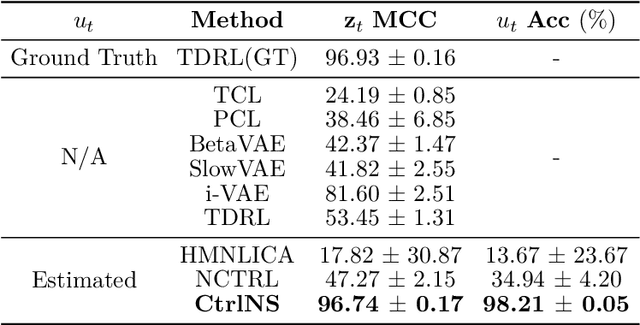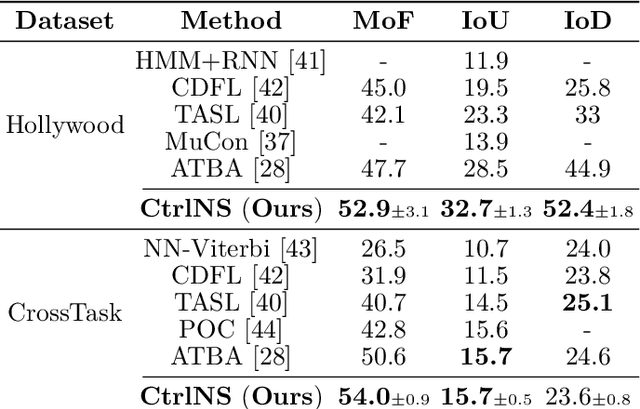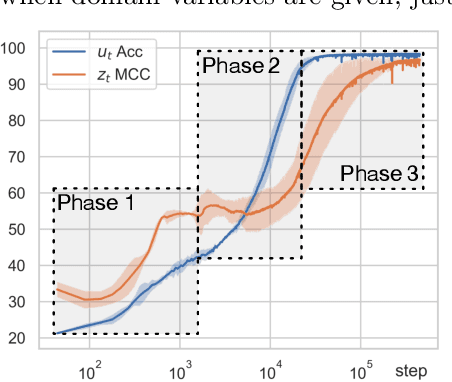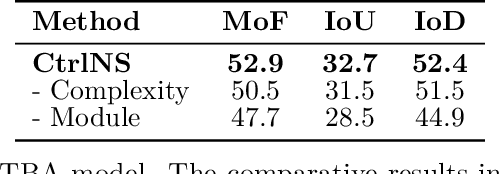Xiangchen Song
Score-based Greedy Search for Structure Identification of Partially Observed Linear Causal Models
Oct 05, 2025Abstract:Identifying the structure of a partially observed causal system is essential to various scientific fields. Recent advances have focused on constraint-based causal discovery to solve this problem, and yet in practice these methods often face challenges related to multiple testing and error propagation. These issues could be mitigated by a score-based method and thus it has raised great attention whether there exists a score-based greedy search method that can handle the partially observed scenario. In this work, we propose the first score-based greedy search method for the identification of structure involving latent variables with identifiability guarantees. Specifically, we propose Generalized N Factor Model and establish the global consistency: the true structure including latent variables can be identified up to the Markov equivalence class by using score. We then design Latent variable Greedy Equivalence Search (LGES), a greedy search algorithm for this class of model with well-defined operators, which search very efficiently over the graph space to find the optimal structure. Our experiments on both synthetic and real-life data validate the effectiveness of our method (code will be publicly available).
Step-Aware Policy Optimization for Reasoning in Diffusion Large Language Models
Oct 02, 2025Abstract:Diffusion language models (dLLMs) offer a promising, non-autoregressive paradigm for text generation, yet training them for complex reasoning remains a key challenge. Current reinforcement learning approaches often rely on sparse, outcome-based rewards, which can reinforce flawed reasoning paths that lead to coincidentally correct answers. We argue that this stems from a fundamental mismatch with the natural structure of reasoning. We first propose a theoretical framework that formalizes complex problem solving as a hierarchical selection process, where an intractable global constraint is decomposed into a series of simpler, localized logical steps. This framework provides a principled foundation for algorithm design, including theoretical insights into the identifiability of this latent reasoning structure. Motivated by this theory, we identify unstructured refinement -- a failure mode where a model's iterative steps do not contribute meaningfully to the solution -- as a core deficiency in existing methods. We then introduce Step-Aware Policy Optimization (SAPO), a novel RL algorithm that aligns the dLLM's denoising process with the latent reasoning hierarchy. By using a process-based reward function that encourages incremental progress, SAPO guides the model to learn structured, coherent reasoning paths. Our empirical results show that this principled approach significantly improves performance on challenging reasoning benchmarks and enhances the interpretability of the generation process.
Position: Mechanistic Interpretability Should Prioritize Feature Consistency in SAEs
May 26, 2025Abstract:Sparse Autoencoders (SAEs) are a prominent tool in mechanistic interpretability (MI) for decomposing neural network activations into interpretable features. However, the aspiration to identify a canonical set of features is challenged by the observed inconsistency of learned SAE features across different training runs, undermining the reliability and efficiency of MI research. This position paper argues that mechanistic interpretability should prioritize feature consistency in SAEs -- the reliable convergence to equivalent feature sets across independent runs. We propose using the Pairwise Dictionary Mean Correlation Coefficient (PW-MCC) as a practical metric to operationalize consistency and demonstrate that high levels are achievable (0.80 for TopK SAEs on LLM activations) with appropriate architectural choices. Our contributions include detailing the benefits of prioritizing consistency; providing theoretical grounding and synthetic validation using a model organism, which verifies PW-MCC as a reliable proxy for ground-truth recovery; and extending these findings to real-world LLM data, where high feature consistency strongly correlates with the semantic similarity of learned feature explanations. We call for a community-wide shift towards systematically measuring feature consistency to foster robust cumulative progress in MI.
Reflection-Window Decoding: Text Generation with Selective Refinement
Feb 05, 2025



Abstract:The autoregressive decoding for text generation in large language models (LLMs), while widely used, is inherently suboptimal due to the lack of a built-in mechanism to perform refinement and/or correction of the generated content. In this paper, we consider optimality in terms of the joint probability over the generated response, when jointly considering all tokens at the same time. We theoretically characterize the potential deviation of the autoregressively generated response from its globally optimal counterpart that is of the same length. Our analysis suggests that we need to be cautious when noticeable uncertainty arises during text generation, which may signal the sub-optimality of the generation history. To address the pitfall of autoregressive decoding for text generation, we propose an approach that incorporates a sliding reflection window and a pausing criterion, such that refinement and generation can be carried out interchangeably as the decoding proceeds. Our selective refinement framework strikes a balance between efficiency and optimality, and our extensive experimental results demonstrate the effectiveness of our approach.
Causal Temporal Representation Learning with Nonstationary Sparse Transition
Sep 05, 2024



Abstract:Causal Temporal Representation Learning (Ctrl) methods aim to identify the temporal causal dynamics of complex nonstationary temporal sequences. Despite the success of existing Ctrl methods, they require either directly observing the domain variables or assuming a Markov prior on them. Such requirements limit the application of these methods in real-world scenarios when we do not have such prior knowledge of the domain variables. To address this problem, this work adopts a sparse transition assumption, aligned with intuitive human understanding, and presents identifiability results from a theoretical perspective. In particular, we explore under what conditions on the significance of the variability of the transitions we can build a model to identify the distribution shifts. Based on the theoretical result, we introduce a novel framework, Causal Temporal Representation Learning with Nonstationary Sparse Transition (CtrlNS), designed to leverage the constraints on transition sparsity and conditional independence to reliably identify both distribution shifts and latent factors. Our experimental evaluations on synthetic and real-world datasets demonstrate significant improvements over existing baselines, highlighting the effectiveness of our approach.
On the Identification of Temporally Causal Representation with Instantaneous Dependence
May 24, 2024


Abstract:Temporally causal representation learning aims to identify the latent causal process from time series observations, but most methods require the assumption that the latent causal processes do not have instantaneous relations. Although some recent methods achieve identifiability in the instantaneous causality case, they require either interventions on the latent variables or grouping of the observations, which are in general difficult to obtain in real-world scenarios. To fill this gap, we propose an \textbf{ID}entification framework for instantane\textbf{O}us \textbf{L}atent dynamics (\textbf{IDOL}) by imposing a sparse influence constraint that the latent causal processes have sparse time-delayed and instantaneous relations. Specifically, we establish identifiability results of the latent causal process based on sufficient variability and the sparse influence constraint by employing contextual information of time series data. Based on these theories, we incorporate a temporally variational inference architecture to estimate the latent variables and a gradient-based sparsity regularization to identify the latent causal process. Experimental results on simulation datasets illustrate that our method can identify the latent causal process. Furthermore, evaluations on multiple human motion forecasting benchmarks with instantaneous dependencies indicate the effectiveness of our method in real-world settings.
When and How: Learning Identifiable Latent States for Nonstationary Time Series Forecasting
Feb 20, 2024



Abstract:Temporal distribution shifts are ubiquitous in time series data. One of the most popular methods assumes that the temporal distribution shift occurs uniformly to disentangle the stationary and nonstationary dependencies. But this assumption is difficult to meet, as we do not know when the distribution shifts occur. To solve this problem, we propose to learn IDentifiable latEnt stAtes (IDEA) to detect when the distribution shifts occur. Beyond that, we further disentangle the stationary and nonstationary latent states via sufficient observation assumption to learn how the latent states change. Specifically, we formalize the causal process with environment-irrelated stationary and environment-related nonstationary variables. Under mild conditions, we show that latent environments and stationary/nonstationary variables are identifiable. Based on these theories, we devise the IDEA model, which incorporates an autoregressive hidden Markov model to estimate latent environments and modular prior networks to identify latent states. The IDEA model outperforms several latest nonstationary forecasting methods on various benchmark datasets, highlighting its advantages in real-world scenarios.
Calibration-then-Calculation: A Variance Reduced Metric Framework in Deep Click-Through Rate Prediction Models
Jan 30, 2024



Abstract:Deep learning has been widely adopted across various fields, but there has been little focus on evaluating the performance of deep learning pipelines. With the increased use of large datasets and complex models, it has become common to run the training process only once and compare the result to previous benchmarks. However, this procedure can lead to imprecise comparisons due to the variance in neural network evaluation metrics. The metric variance comes from the randomness inherent in the training process of deep learning pipelines. Traditional solutions such as running the training process multiple times are usually not feasible in deep learning due to computational limitations. In this paper, we propose a new metric framework, Calibrated Loss Metric, that addresses this issue by reducing the variance in its vanilla counterpart. As a result, the new metric has a higher accuracy to detect effective modeling improvement. Our approach is supported by theoretical justifications and extensive experimental validations in the context of Deep Click-Through Rate Prediction Models.
CaRiNG: Learning Temporal Causal Representation under Non-Invertible Generation Process
Jan 25, 2024



Abstract:Identifying the underlying time-delayed latent causal processes in sequential data is vital for grasping temporal dynamics and making downstream reasoning. While some recent methods can robustly identify these latent causal variables, they rely on strict assumptions about the invertible generation process from latent variables to observed data. However, these assumptions are often hard to satisfy in real-world applications containing information loss. For instance, the visual perception process translates a 3D space into 2D images, or the phenomenon of persistence of vision incorporates historical data into current perceptions. To address this challenge, we establish an identifiability theory that allows for the recovery of independent latent components even when they come from a nonlinear and non-invertible mix. Using this theory as a foundation, we propose a principled approach, CaRiNG, to learn the CAusal RepresentatIon of Non-invertible Generative temporal data with identifiability guarantees. Specifically, we utilize temporal context to recover lost latent information and apply the conditions in our theory to guide the training process. Through experiments conducted on synthetic datasets, we validate that our CaRiNG method reliably identifies the causal process, even when the generation process is non-invertible. Moreover, we demonstrate that our approach considerably improves temporal understanding and reasoning in practical applications.
A Versatile Causal Discovery Framework to Allow Causally-Related Hidden Variables
Dec 18, 2023



Abstract:Most existing causal discovery methods rely on the assumption of no latent confounders, limiting their applicability in solving real-life problems. In this paper, we introduce a novel, versatile framework for causal discovery that accommodates the presence of causally-related hidden variables almost everywhere in the causal network (for instance, they can be effects of observed variables), based on rank information of covariance matrix over observed variables. We start by investigating the efficacy of rank in comparison to conditional independence and, theoretically, establish necessary and sufficient conditions for the identifiability of certain latent structural patterns. Furthermore, we develop a Rank-based Latent Causal Discovery algorithm, RLCD, that can efficiently locate hidden variables, determine their cardinalities, and discover the entire causal structure over both measured and hidden ones. We also show that, under certain graphical conditions, RLCD correctly identifies the Markov Equivalence Class of the whole latent causal graph asymptotically. Experimental results on both synthetic and real-world personality data sets demonstrate the efficacy of the proposed approach in finite-sample cases.
 Add to Chrome
Add to Chrome Add to Firefox
Add to Firefox Add to Edge
Add to Edge